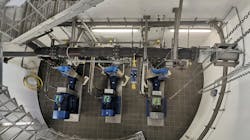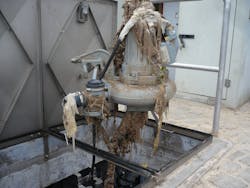Clogging — or ‘ragging’ — of pumps has become a huge problem for the global wastewater business. In the United Kingdom alone, it is estimated that water companies respond to around 300,000 blockages a year — at an annual cost of over €117 billion (US$138 million). However, there is a cost-effective and straightforward potential solution in the form of water-dedicated variable speed drives (VSDs) that integrate pump cleaning functions.
A Growing Challenge
Increasing amounts of fat, oil and grease (FOG) are entering household and commercial drains. Within the sewerage system they solidify, form floating crusts, coat pipe and pump surfaces, and envelop solid objects. These include items like wet wipes, sanitary products, cotton buds and even diapers, carelessly flushed down toilets. The resulting masses continue to gather FOG and other materials, creating fatbergs ranging in size from small to enormous proportions. The situation is not helped by today’s trend for toilet cisterns designed to deliver flushes with a reduced volume of water which — although sensible as a water conservation measure — make it easier for FOG to settle and aggregate.
At their worst, blockages can stop a pump from working. It then needs to be mechanically lifted, opened up and manually cleaned. The downtime and labor costs involved are particularly high for pumps in remote locations. At lower levels, ragging adversely affects the pump’s performance. Flows are reduced and extra strain is placed on the pump, resulting in higher energy consumption and faster wear. This in turn increases the need for inspection and maintenance action. A serious by-product of pump failure or loss of effectiveness may be flooding, which risks damage to property, pollution of natural waters, a need for clean-up operations, and fines — all of which add further expense. In addition, whenever floods occur or pumps need to be removed and handled, maintenance teams and communities are exposed to biohazards.
Setting Pumps Free
The latest generation of VSDs for the water industry enable precise control of pump activity. This includes cleaning sequences in which the pump’s impeller performs a series of rapid forward and reverse movements to dislodge attached or entangled solids. The number, duration, acceleration rate and pattern of these movements can be adjusted to suit different solid materials or mixes. Cleaning action can be programmed to trigger automatically when a possible blockage is indicated by a reduction in flow rate. Operators can also decide how many times the cleaning routine should be activated before a warning of potential trouble is generated.
It is worth mentioning that some operators have addressed their blockage issues successfully by installing macerator or chopper pumps. However, in some cases, this approach might cause problems downstream, as the smaller pieces may pass through screens at treatment works. This creates fragments that are difficult to remove and may disrupt processes. In contrast, VSD automated cleaning keeps large objects moving along to the screens, where they can be easily extracted, dewatered and — in many cases — used to feed energy conversion plants.
Practical Examples
A tried and tested example of a VSD with cleaning functionality for the water industry is the ABB water dedicated ACQ580. Using this drive has doubled or even tripled flow rates in some installations, while optimizing the pumps’ operation for maximum energy efficiency.
Mittelmärkische Wasser- und Abwasser GmbH (MWA) in Brandenburg, Germany, has used the VSD pump cleaning function since 2014. When the current rises due to clogging, the VSD switches the pump into reverse operation or a higher speed. The company hasn’t experienced any clogging since the VSDs were installed.
At a smaller scale, the municipally-owned Pietarsaaren Vesi utility on the west coast of Finland serves a population of 20,000. Around 80 percent of the area’s wastewater flows through one unmanned pumping station on its way to a central treatment plant. Controlling flow to avoid flooding is a priority, as spills into the sea could cause severe ecological damage. Before installing VSDs with integrated cleaning capability, clogging was a major issue which frequently required pumps to be pulled up and manually cleaned. Now, the cleaning function is activated on a weekly basis as a routine precautionary measure, or whenever a spike in current drawn by a pump indicates a blockage.
In Queensland, Australia, Unitywater provides water and sewerage services for more than 820,000 people and operates 17 sewage treatment plants. Its Deception Bay pumping station alone handles 1.2 million liters of wastewater per day using two pumps. These suffered clogging and needed to be removed regularly using specialized lifting gear. Simultaneous failure of both pumps would have incurred the additional expense of transporting extra pumping equipment to keep the site operating.
Installing VSDs with cleaning functionality has meant no more lifts and has saved around AUS$27,000 (US$20,000) each year in maintenance costs. Water flow has doubled, without a corresponding increase in pump speed, so component wear and energy consumption are reduced. Electricity bills have been halved. A full return on investment has taken less than six months.
Clean and Adaptable
The steady, calm flow achieved by these drives not only allows pumps to operate at optimum speed for energy efficiency but feeds treatment works at consistent rates. This is highly beneficial when it comes to managing biological and chemical processes. Sustainability benefits from reducing blockages relate to overall reduction of carbon footprint and power consumption. In this respect, the CO2 emissions of vehicles traveling long distances to deal with blocked pumps need to be considered. Sometimes a single incident requires the presence of a crane operator and more than one specialized engineer, each arriving in separate vehicles.
Adaptability to changing needs in the future is another key VSD benefit. For instance, catchment sizes and conditions may alter over time, making initial flow estimates inaccurate. Oversized pumps are often specified to allow for such variation, but this adds to running costs. With VSDs, pumps can instead be adjusted as and when necessary to match new requirements optimally.
An associated function manageable by VSDs is the capability for flow measurement in applications where a dedicated flow meter is not available. Knowledge of sewage flows can be very useful. It allows, for example, early warning of increased loads, clarification of diurnal patterns and indication of leakage. ABB’s particular solution has a unique inbuilt flow calculator and is able to make measurements without inserting sensors (which could obstruct and entangle solid waste).
Specialist Installation and Commissioning is Critical to Success
Although the VSD solutions described here are quick and easy to retrofit, generally without large civil engineering costs, buyers should factor specialist installation, commissioning and support into their investment. Whether provided directly by the supplier or through its delivery partners, expert knowledge in this field will ensure that the equipment is correctly specified and set up for the specific application and circumstances.
Without such expertise, VSDs may not achieve optimum results and could even increase energy use. Importantly, expert installation will ensure that the nature and needs of existing systems, construction, and components are understood, and that VSD operation and cleaning is programmed to ensure smooth and reliable pump operation from the start.
As an example, the Australian plant discussed above had a nearby non-return valve which was sensitive and vulnerable to disruption and damage. In this case, careful management and fine tuning averted the problem.
While water companies continue to educate consumers on the impacts of flushing inappropriate materials, the message is clearly not reaching everyone. Keeping pumps and sewage moving therefore depends heavily on applying specialist technology and experience. WW
About the Author: James Chalmers is vice president of sales at ABB Drives. He has been working with automation and control products for 18 years and with the water industry for 10 years.
About the Author
James Chalmers
James Chalmers is Vice President, Global Water and Wastewater with ABB Motion.


